Enabling PBB-TE and MPLS seamless services
November 2007

I havn't quite decided whether there is a true religious war between the now ubiquitous MPLS and the more recent PBB-TE (Provider Backbone Bridging Traffic Engineering) Ethernet technologies. It certainly seems that way sometimes! However, everything has its time and place and that applies to network technologies as well.
On one hand, MPLS is now the de rigueur technology for use in the core of the world's IP-based 'converged' networks. MPLS enables IP to be tamed to a degree by providing deterministic (i.e. predictable) routing and QoS. Deterministic routing forces traffic over a predetermined path so that all packets on that path will experience the same delay. This is an absolute necessity for real-time traffic such as Voice-over-IP, video conferencing and IP-TV services. MPLS also enables traffic to be categorised so that real-time services take preference over non-critical traffic such as email at busy times on the network. I've covered much of this in previous posts such as The rise and maturity of MPLS.
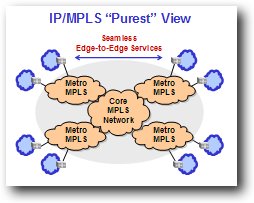 If your network strategy
guys come from the 'purist' MPLS camp then it is clear that they will see MPLS being deployed both in the core and metro access network. However, MPLS is often now seen as an expensive and complex
technology to maintain in real environments and this has prevented carriers from rolling out MPLS to the edge of their networks, often known as local metro-networks. A carrier usually has only one
core network but often has many local access or metro networks which directly connect to their customers' buildings and private LANs. If MPLS were deployed throughout this infrastructure costs
could skyrocket.
If your network strategy
guys come from the 'purist' MPLS camp then it is clear that they will see MPLS being deployed both in the core and metro access network. However, MPLS is often now seen as an expensive and complex
technology to maintain in real environments and this has prevented carriers from rolling out MPLS to the edge of their networks, often known as local metro-networks. A carrier usually has only one
core network but often has many local access or metro networks which directly connect to their customers' buildings and private LANs. If MPLS were deployed throughout this infrastructure costs
could skyrocket.
A consequence of this is that the industry has been looking for a lower cost alternative as the technology of preference for use in these access networks. As the transport of preference for enterprises is Ethernet it comes as no surprise that there has been tremendous interest in using Ethernet in carriers' access networks as it could prove to be a lower cost solution than MPLS. It has been conjectured that the deployment of PBB-TE rather than MPLS could save in excess 40% of costs. This will be the subject of a future post.
This vision has driven a tremendous amount of standards activity that has resulted in the PBB-TE standard whereby inappropriate features have been stripped out of Ethernet to create a transport technology that can be used in carrier's access networks. I've previously written about these initiatives in my posts - Ethernet goes carrier grade with PBT / PBB-TE? and PBB-TE / PBT or will it be T-MPLS?.
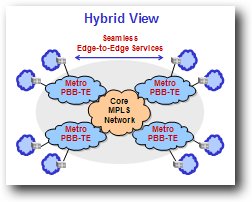 If the above scenario is to
pan out in practice, then carriers must be able to to seamlessly and transparently deploy and manage services across both technologies and this has been a real if not impossible challenge to date.
This has much to do with the immaturity of PBB-TE technology and lack of compatibility with MPLS. For example, MPLS uses pseudowire tunnels for the transport of services across a core
network, while PBB-TE uses E-LINE which has been defined by the Metro Ethernet Forum (MEF).
If the above scenario is to
pan out in practice, then carriers must be able to to seamlessly and transparently deploy and manage services across both technologies and this has been a real if not impossible challenge to date.
This has much to do with the immaturity of PBB-TE technology and lack of compatibility with MPLS. For example, MPLS uses pseudowire tunnels for the transport of services across a core
network, while PBB-TE uses E-LINE which has been defined by the Metro Ethernet Forum (MEF).
Earlier this week I listened to a most interesting webinar from Hammerhead Systems a USA company who have been focusing on this issue and I would like to thank them for allowing me to use some of their graphics in this post.
It was interesting to hear a clearly articulated vision for a future network strategy based on a technology agnostic view. The term 'technology agnostic' in this case means a future based on hybrid networks based on a mechanism whereby MPLS and PBB-TE are able to inter-work. Of course, I'm sure many would see this as a first step to an MPLS-free future, however that could be seen as a bit extreme and I'm sure Hammerhead would never articulate this view!
One of the weaknesses of PBB-TE is the lack of a workable control plane so Hammerhead have partnered with Soapstone in this announcement. Interestingly, Soapstone is a division of a company that I used know quite well, Avici.
Avici came to fame with a terabit router in the late 1990s but with the down turn in the market they decided to focus on providing software to support converged Next Generation Networks. They say they "Provide an abstraction layer that decouples service from the network". The availability of this portable abstraction layer is the one of the key needs to enable seamless inter-operation between MPLS and and PBB-TE.
 In the webinar, Dr. Ray Mota, Chief
Strategist and President of Consulting Synergy Research Group, presented a view of PBB-TE past and PBB-TE future. As it's nearing
Christmas this reminded me of Dickens's Christmas Carol, but I digress...
In the webinar, Dr. Ray Mota, Chief
Strategist and President of Consulting Synergy Research Group, presented a view of PBB-TE past and PBB-TE future. As it's nearing
Christmas this reminded me of Dickens's Christmas Carol, but I digress...
PBB-TE (past) was profiled as being designed as a replacement for traditional point-to-point SONET/SDH trunks supporting enterprise Ethernet services. However, there are some key pieces missing and this was what the webinar was all about.
PBB-TE (future) is about a "Generalized Services Infrastructure" that is independent of MPLS or PBB-TE transport layers. The joint announcement encompassed the following components of this Generalized Services Infrastructure which claimed to be the "first seamless support across PBB-TE metro networks and MPLS cores" running on Hammerhead's HSX 6000 PBB-TE Service Gateway�.
-
Multipoint-to-Multipoint (MP2MP): Hammerhead's PBB-TE E-LAN
-
Point-to-Multipoint (P2MP): Hammerhead's PBB-TE E-tree
-
Multicast and Multipoint applications: PBB-TE E-Tree for IPTV, IP-VPN, Multicast, and Enterprise Managed Services
-
Seamless solutions across MPLS/VPLS and PBB-TE: Hammerhead's Service gateway for inter-working of MP2MP and P2MP PBB-TE solutions with MPLS/VPLS
-
Control Plane Provisioning: Support for MP2MP and P2MP PBB-TE solutions through the Soapstone partnership.
-
All of these services supported with MultiClass QoS
An example of a service - business multicast - that could be deployed across a mixed infrastructure is shown below.
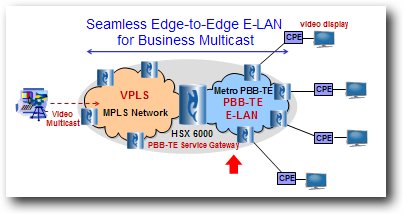
Hammerhead make extensive use of the IETF's Virtual Switch Instance (VSI) as a building block to enable a capability to support both pseudowire trunks across MPLS and PBB-TE trunks based on MEF E-LAN. The diagram below shows how a seamless service can be created:
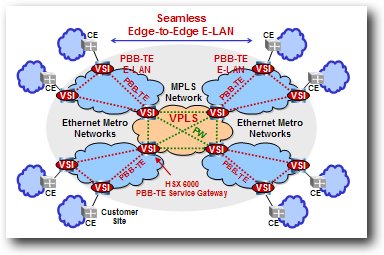
One of the key services that is driving converged NGN networks is IP-TV and the MEF E-Tree specification provides the multicast capability these types of service require. Again, Hammerhead support this stanfdard on PBB-TE and MPLS.
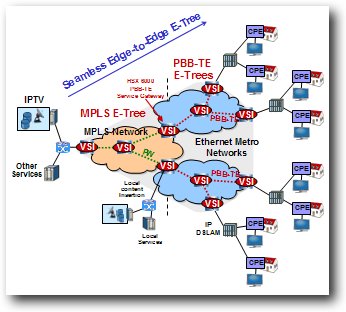
In practice, Hammerhead�s multicast solutions for PBB-TE networks use Soapstone Networks� Provider Network Controller (PNC) control plane which decouples the control and data planes enabling Hammerhead's E-LAN and E-Tree services to run without the development of new protocols. Also, Hammerhead�s VPLS and MPLS E-Tree solutions use existing MPLS control protocols.
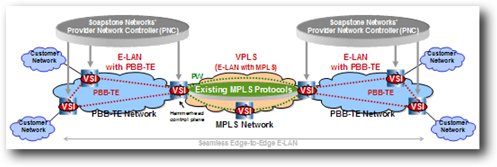
Roundup
I don't normally make my technology posts so focused on a particular vendor's product set but I wanted to make an exception in this case. I certainly would not be able to confirm that what Hammerhead have announced is truly unique, but it does seem to be a first from my limited visibility. I have also been interested in what Soapstone are doing for some time as well. Perhaps this partnership is a marriage in heaven?
We can all do without technology wars. The telecommunications industries, whether they be fixed or mobile, really do need to focus on providing the innovative services that their customers can use. Moreover, they do need realise that moving packets from one location to another is a commodity service that needs to be offered with exceptional reliability, high customer service but also at low cost. To me, commoditisation is a good thing and not to be something to be frightened of and avoid by trying to jump into so-called value added services to avoid the margin crush. The commoditisation of the computer market following the personal computer steamroller can hardly be seen as a bad thing, but it does mean that infrastructure costs have to come down in step with average service selling prices.
MPLS is a high cost marriage partner and carriers should be looking at alternative technologies to see if they can help reduce costs. Unfortunately it is often the case that equipment vendors are not technology agnostic (PBT could be catastrophic, says Juniper CEO) and that is very much the case with MPLS. Of course, once a technology really starts to take off - as demonstrated by IP - then every vendor jumps on the bandwagon!
Providing a solution that enables carriers to deploy the most appropriate and cost effective technologies in access and core networks AND to be able to provision and manage services seamlessly, seems to me to be a 'no brainer' idea which should receive much interest. It is certainly good to be able to identify one company that can help carriers achieve this goal and it will certainly help PBB-TE gain further credibility.
I certainly predict that the majority of incumbent and alternative carriers that need to connect with customer premises will, if they are not today, evaluate the use PBB-TE to ascertain whether the cost reduction promises are real. Hammerhead's and Soapstone's solution could provide a key element in that evaluation. If they are truly unique with this announcement, then they won't be for long as every other vendor will try and catch up!
